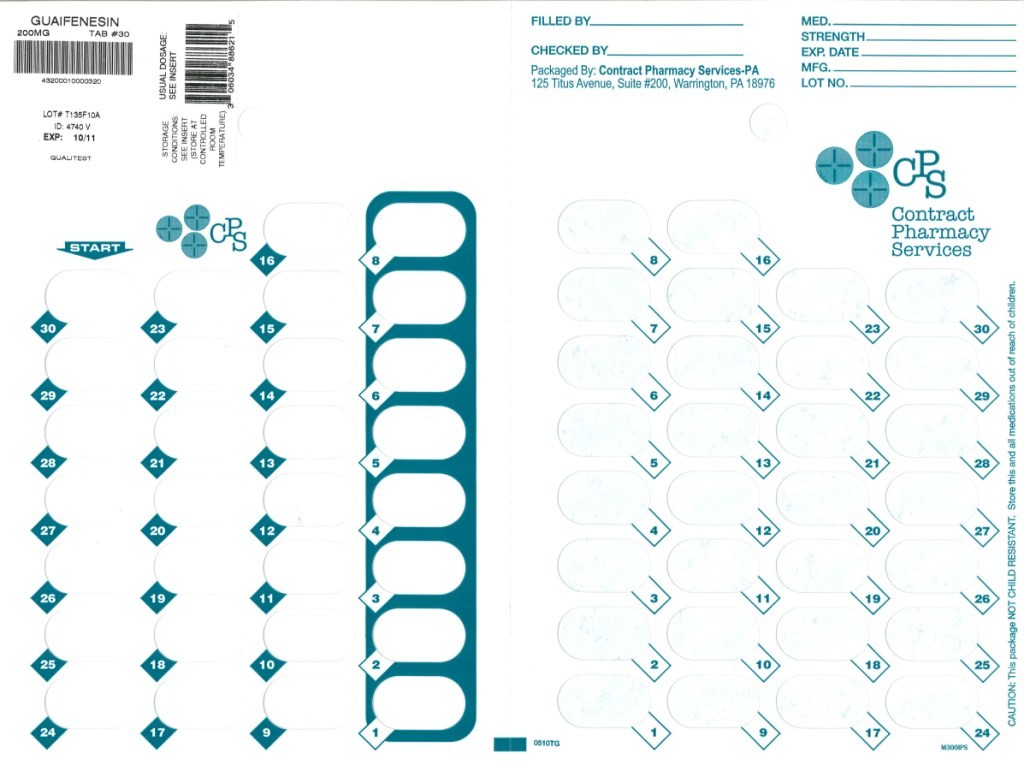Guaifenesin
Professional Labeling Information and Directions for Use These products labeled for sale on prescription only. Guaifenesin Tablets
FULL PRESCRIBING INFORMATION: CONTENTS*
- GUAIFENESIN DESCRIPTION
- CLINICAL PHARMACOLOGY
- GUAIFENESIN INDICATIONS AND USAGE
- GUAIFENESIN CONTRAINDICATIONS
- PRECAUTIONS
- GUAIFENESIN ADVERSE REACTIONS
- OVERDOSAGE
- GUAIFENESIN DOSAGE AND ADMINISTRATION
- HOW SUPPLIED
FULL PRESCRIBING INFORMATION
GUAIFENESIN DESCRIPTION
Guaifenesin (glyceryl guaiacolate) has the chemical name 3-(2-methoxyphenoxy)-1,2-propanediol. Its molecular formula is C10H14O4 with a molecular weight of 198.21. It is a white or slightly gray crystalline substance with a slightly bitter aromatic taste. One gram dissolves in 20 mL water at 25°C; it is freely soluble in ethanol. Guaifenesin is readily absorbed from the GI tract and is rapidly metabolized and excreted in the urine. Guaifenesin has a plasma half-life of one hour. The major urinary metabolite is β-(2-methoxyphenoxy) lactic acid.
Guaifenesin is an expectorant available for oral administration as:
Tablets — each containing 200 mg guaifenesin, USP.
Other ingredients: crospovidone, D&C red #30 aluminum lake, magnesium stearate, microcrystalline cellulose, polysaccharides, pregelatinized starch, silicon dioxide, sodium starch glycolate, and stearic acid.
CLINICAL PHARMACOLOGY
Guaifenesin is an expectorant, the action of which promotes or facilitates the removal of secretions from the respiratory tract. By increasing sputum volume and making sputum less viscous, guaifenesin facilitates expectoration of retained secretions.
GUAIFENESIN INDICATIONS AND USAGE
Helps loosen phlegm (mucus) and thin bronchial secretions to rid the bronchial passageways of bothersome mucus, drain bronchial tubes and make coughs more productive. Helps loosen phlegm and thin bronchial secretions in patients with stable chronic bronchitis.
GUAIFENESIN CONTRAINDICATIONS
Hypersensitivity to any of the ingredients.
PRECAUTIONS
Carcinogenesis, Mutagenesis, Impairment of Fertility: Animal studies to assess the long-term carcinogenic and mutagenic potential or the effect on fertility in animals or humans have not been performed.
Pregnancy:
Teratogenic Effects—Pregnancy Category C: Animal reproduction studies have not been conducted. Safe use in pregnancy has not been established relative to possible adverse effects on fetal development. Therefore, these products should not be used in pregnant patients unless, in the judgment of the physician, the potential benefits outweigh possible hazards.
Nursing Mothers: It is not known whether guaifenesin is excreted in human milk. Because many drugs are excreted in human milk, caution should be exercised when these products are administered to a nursing woman and a decision should be made whether to discontinue nursing or to discontinue the drug, taking into account the importance of the drug to the mother.
Laboratory Test Interactions: Guaifenesin or its metabolites may cause color interference with the VMA (vanillylmandelic acid) test for catechols. It may also falsely elevate the level of urinary 5-HIAA (5-hydroxyindoleacetic acid) in certain serotonin metabolite chemical tests because of color interference.
GUAIFENESIN ADVERSE REACTIONS
To report SUSPECTED ADVERSE REACTIONS, contact FDA at 1-800-FDA-1088 or www.fda.gov/medwatch .
Guaifenesin is well tolerated and has a wide margin of safety. Side effects have been generally mild and infrequent. Nausea and vomiting are the side effects that occur most commonly. Dizziness, headache, and rash (including urticaria) have been reported rarely.
OVERDOSAGE
In massive overdosage the stomach should be emptied (emesis and/or gastric lavage) and further absorption prevented. Treatment is symptomatic and supportive.
The acute toxicity of guaifenesin is low and overdosage is unlikely to produce serious toxic effects. In laboratory animals no toxicity resulted when guaifenesin was administered by stomach tube in doses up to 5 grams/kg.
GUAIFENESIN DOSAGE AND ADMINISTRATION
Adults and children 12 years of age and older: One to 2 tablets (200 mg to 400 mg) every four hours, not to exceed 2400 mg (12 tablets) in 24 hours.
PATIENTS SHOULD BE ADVISED TO KEEP THESE AND ALL DRUGS OUT OF THE REACH OF CHILDREN AND TO SEEK PROFESSIONAL ASSISTANCE OR CONTACT A POISON CONTROL CENTER IMMEDIATELY IN CASE OF ACCIDENTAL OVERDOSE.
HOW SUPPLIED
Guaifenesin
Tablets — Each round, scored, rose-colored tablet contains 200 mg guaifenesin USP—available in blisters of 30 (NDC 67046-250-30)
STORAGE — Store at controlled room temperature 20°-25°C (68°-77°F). Protect tablets from moisture. Keep bottle tightly closed.
To report SUSPECTED ADVERSE REACTIONS, contact FDA at 1-800-FDA-1088 or www.fda.gov/medwatch .
Qualitest PHARMACEUTICALS®
Huntsville, AL 35811
8180142 Rev 5/08

Guaifenesinguaifenesin TABLET
| ||||||||||||||||||||||||||||||||||||||||||||||||||||||||||||||||||||||||||||||||